Ferratelle
Especially popular at Christmas, Easter and weddings, ferratelle are a classic Abruzzese treat. In other parts of Italy these delightful waffle cookies are known as pizzelle, nevole, catarrette, cancellette and more, but in Abruzzo where my grandfather Gaetano Crocetti was born they are known as ferratelle. The implements used to make the cookies first appeared in the late eighteenth century and were fashioned of iron, ferro in Italian – and the cookies were dubbed ferratelle. Lu ferro, as the iron is known, consists of two plates, most often rectangular, each attached to a long handle and secured with a locking mechanism. The inside of the plates, the side on which the cookies are baked, is etched with a grate-like design. Some say the name cancellette and the grate-like design were inspired by the screens in nunneries. Dough or batter is placed on one of the plates, the long handle locked closed and the plates held over an open fire. If you come across old ferratelle irons you may see initials, family insignias or names etched on the inside of one of the plates. It was customary for a family to have their own iron, often a prized wedding gift. They are beautiful tools, and after many years of use and thousands of cookies, the irons take on a stunning patina and wonderful non-stick finish, just like nonna’s cast iron frying pan. Should you be lucky enough to have an original etched iron, well then, I am envious. Very envious.
Nowadays most families have an electric ferratelle maker. They are sold in the U.S. as pizzelle makers, and they look like small waffle irons. Aluminum irons for stovetop and hearth use are also available. Both electric and stovetop types can be purchased at Amazon and many specialty shops. For an authentic iron you will need to make a trip to an antique store or nonna’s basement or attic.
 Lots of cultures make a cookie like this, the most famous being the Norwegian Krumkake. Of course we are talking about Italy where the tradition of mille nonne is at work – a thousand grandmothers – a thousand recipes, and almost as many names. All ferratelle, or pizzelle, have four ingredients in common – flour, sugar, eggs, and some kind of fat – butter, olive oil, lard, vegetable oil, even margarine. From there the road diverges. The most common flavoring is anise, either ground seeds, oil or extract, and in widely varying amounts. I like just a hint almost more for aroma than taste, but some recipes call for much more. Use what ever amount pleases you, a recipe direction the Italians express as quanto basta, q.b.
Lots of cultures make a cookie like this, the most famous being the Norwegian Krumkake. Of course we are talking about Italy where the tradition of mille nonne is at work – a thousand grandmothers – a thousand recipes, and almost as many names. All ferratelle, or pizzelle, have four ingredients in common – flour, sugar, eggs, and some kind of fat – butter, olive oil, lard, vegetable oil, even margarine. From there the road diverges. The most common flavoring is anise, either ground seeds, oil or extract, and in widely varying amounts. I like just a hint almost more for aroma than taste, but some recipes call for much more. Use what ever amount pleases you, a recipe direction the Italians express as quanto basta, q.b.
I have seen recipes that call for cinnamon, cannella in Italian. Some add vanilla powder or extract, almond oil or extract, lemon or orange zest, oil or extract, or one of my favorites, Fiori di Sicilia. Fiori di Sicilia is a potent mix of orange, vanilla and jasmine, and is available from King Arthur. And since we are talking Abruzzo, source of some of the finest saffron (zafferano) in the entire world, when a cook really wants to splurge she will add some to the mix. For an extra depth of flavor I use brown butter, butter that has been heated to the point where it melts and the milk solids begin to brown. The amazing thing about brown butter is how something so simple to make can have such a complex flavor and add so much to a dish. Whether you put it on eggs, vegetables, fish or add it to a dessert, it brings a unique depth of flavor to any dish. I think of brown butter as a great ingredient that is less than five minutes away; if you’ve got butter, a saucepan and a burner, you’ve got brown butter. But let me emphasize – this step is my addition and in no way traditional, except in my kitchen. Feel free to skip it.
Here is a short clip on how to make brown butter.
These cookies are most often left flat, but they can also be molded right after baking. You can wrap them around cannoli tubes and fill them with whipped cream, pastry cream, Nutella, honey or other filling. You can also form them into cones by wrapping the still hot cookie around a wooden cone mold.
Ferratelle recipes produce every consistency from malleable doughs to loose batters and all points in between. My electric unit produces circular cookies, so I form the dough into balls. If you will be using a hand held iron, either at the stovetop or the hearth, I suggest you use a recipe that will produce a dough-like, or at least a paste-like consistency. The experience will be much more pleasant and much less messy than if you use a batter. And if you are using an iron with rectangular plates, tradition dictates that you form each piece of dough into rope and then into a figure eight to ensure even coverage of the cooking surface. And the cooking time for the hand held irons? Yield to tradition – for the first side say an Ave Maria, give the iron a flip, say a Pater Noster and the cookie is done. I just love Italian food.
Gently fold in flour mixture in three additions.
Ferratelle
makes about 30
1 3/4 cup all-purpose flour
1 stick (8 tablespoons) unsalted butter, browned and cooled
1/2 cup granulated sugar
2 large eggs plus 1 large egg yolk
1 packet (una bustina) of Vanillina* OR 1teaspoon vanilla extract
anise oil, q.b.
1 teaspoon baking powder
pinch kosher salt
This recipe will produce a malleable dough. These directions are for an electric unit.
Place a towel beneath the iron to capture any fat that may leak. Heat iron.
Brown the butter. Set aside. Watch my video to learn how to make brown butter, burro nocciola to the Italians.
In a small bowl combine flour, baking powder and salt. Set aside.
In a medium bowl beat eggs and sugar until light in color.
Add melted butter, vanilla and anise oil. Combine well.
Gently fold in flour mixture in three additions. Dough will come together in a firm ball.
Pinch off a tablespoon of dough and form into a ball. Repeat with remaining dough.
Place 1 ball of dough on each plate. Close and lock lid.
Bake until steam subsides, about 35 to 40 seconds, depending on your iron and on how brown you want your ferratelle. Remove to rack to cool. If you are going to form the ferratelle into cones or tubes, do so when they are hot.
Bake until steam subsides, about 35 to 40 seconds, depending on your iron and on how brown you want your ferratelle. Remove to rack to cool. If you are going to form the ferratelle into cones or tubes, do so when they are hot.
* I like to use Vanillina Pura, a vanilla powder manufactured by Fratelli Rebecchi. It is available at many Italian markets, and online at Amazon.
Note: You can click on any picture to see a slide show!
I have no affiliation with any product, manufacturer, or site mentioned in this article.
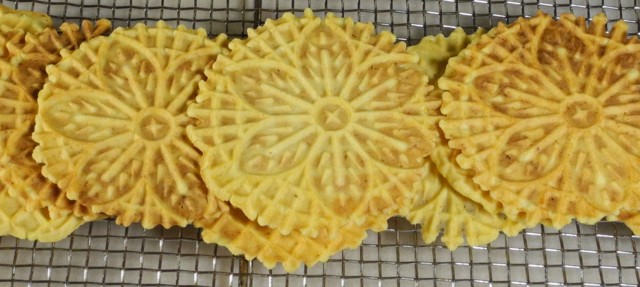
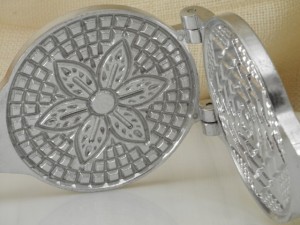
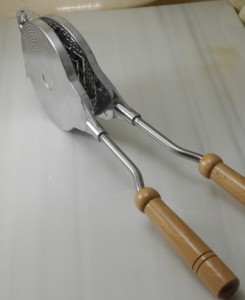

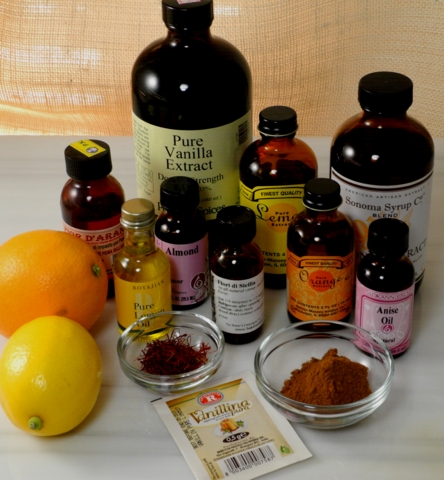

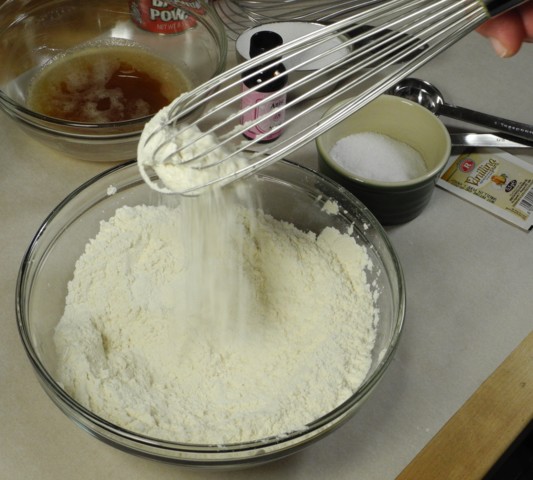
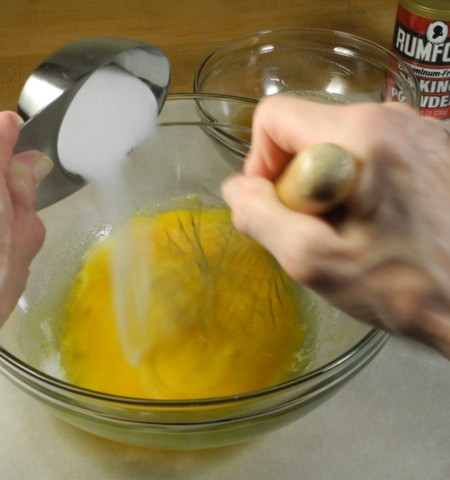

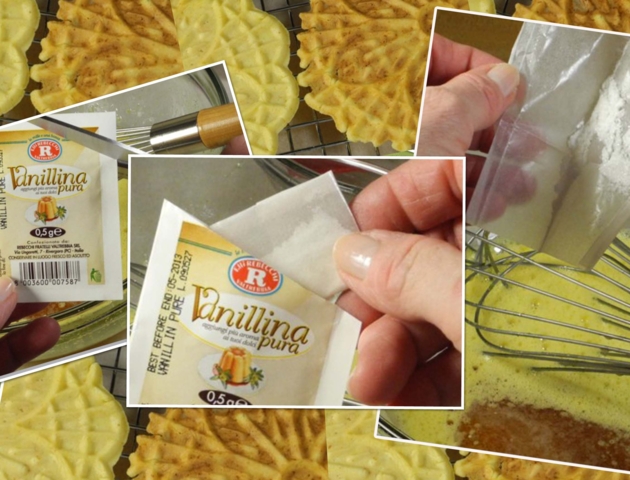

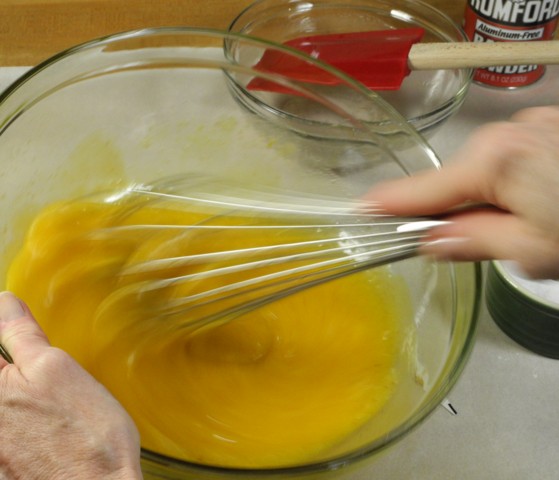

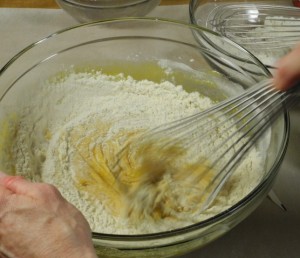

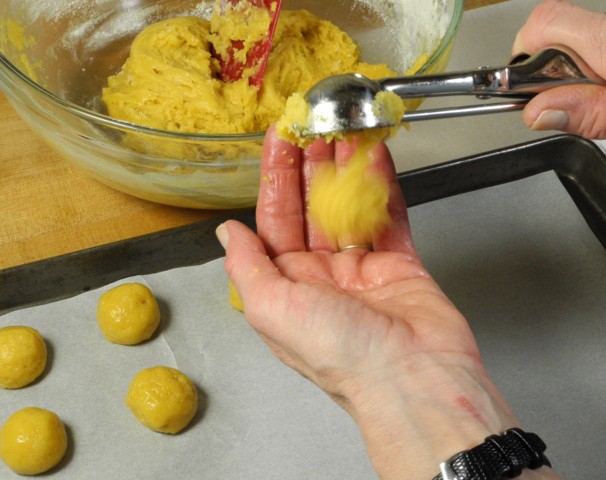

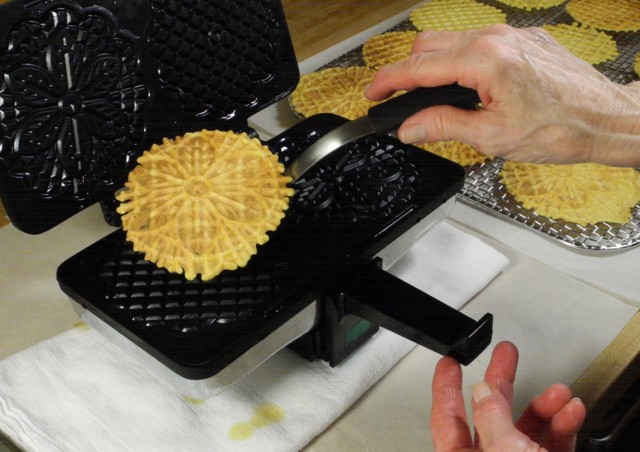


Tuesday, January 25th 2011 at 8:08 pm |
Woooowww Adri! I love the video for making browned butter. Your tips for making it are so helpful too. I’m surprised how yellow your dough is. I bet the eggy-ness makes them very flavorful. I also like your new “action” step-by-step photography. Oh yeah….nice VillaWare Pizzelle Maker too! 😀
Tuesday, June 28th 2011 at 3:02 am |
This is just amazing! My father is from Abruzzo and I used to eat these when I was a kid and visited my grandparents. I remember one of the relatives of my father, called Remo, used to have a small factory making these, and when I visited it I had plenty 🙂
Tuesday, June 28th 2011 at 7:01 am |
Thanks so much for visiting my site. Part of what I love about blogging is meeting and sharing food stories with new people. I am so glad this post brought back memories . I just love those cookies. And how i wish I had an antique iron!
Sunday, October 16th 2011 at 1:27 pm |
Hi Adri!
I’ve been meaning to ask you, how does the flavor of the vanilla powder compare to vanilla extract? Why do you prefer it? Do you prefer it for certain recipes only or for other foods as well?
Sunday, October 16th 2011 at 11:03 pm |
Hi Irene, Vanilla powder does not have as full or round a depth of flavor as a fine extract and imparts a more mild vanilla flavor. I like to work with it for the “authentic” factor when I feel that a fine extract would not be so superior that it would be imprudent to go for the powder. For lots of people its use is not an option, as vanilla powder (Vanillina) is not available worldwide. Overall, however I’d say that if I could have only one vanilla, it would be a fine extract, either commercial or homemade by infusing neutral spirits with very high quality split vanilla beans.
Wednesday, December 7th 2011 at 11:31 am |
I would like to get a copy of this great recipe. It is just great. Comes out perfect. I do believe that my nonna would very proud that I was able to come very close to hers.
Wednesday, December 7th 2011 at 1:59 pm |
Benvenuto!
I am so pleased to hear you have had success with this recipe. I hope the step by step instructions were of value to you. To print the recipe, just scroll down to the bottom of the article, beneath the last photograph where you will see a small square that says Create a PDF of this post. Click on the square icon, and a menu will appear. Click on Download, the second option. That will open the PDF and you can then print or save it. These cookies are an Abruzzese specialty, and I love them. If you have Abruzzo on your mind, please look at my article on another specialty from the region,- maccheroni alla chitarra. I take great pleasure in displaying readers’ photographs of recipes from my site that they have tried. Next time you make these, I would love it if you would send a photo to me for my Readers’ Gallery. Let me know how the printing goes. Buone feste!
Friday, December 30th 2011 at 12:28 pm |
Hi Adri!
We made your ferratelle yesterday. You are right – the browned butter adds a nice depth of buttery/toasted flavor! It was well worth the effort. My teenage son watched your video and browned the butter for me…exactly as shown! We made vanilla ones, then followed with an almond variation (Amaretto plus finely chopped almonds) and a chocolate variation (cocoa powder in place of some of the flour) — all were great! Since we like things sweet here, we did add 1/4 cup of additional sugar. I’m sure it would have been fine the way you wrote it as well. Since this dough is thicker than other pizzelle recipes, it is good you say to lock the handle during “baking”. I overlooked your directions at first, and the initial ones were a little thick. Locking the handles solved the problem! Thank you for the wonderful pizzelle recipe – they are the best!
Friday, December 30th 2011 at 8:22 pm |
Benvenuto!
I am so pleased to hear that you made the Ferratelle. And how cool that you have made them your own. Funny, but I was just thinking about making both almond and chocolate versions. Would you consider sharing your recipes? And I would love to have a photo of your creations to display in my Readers’ Gallery. Do you have a any pix? And finally, congratulazioni to the teenage chef. It is good to hear that my video was really of use! Thanks for commenting, and I hope you return often. Best wishes for a Happy New Year!
Saturday, December 31st 2011 at 2:51 pm |
For the almond ferratelle, I prepared your recipe (with the 3/4 cup of sugar) and used 2 tablespoons of Amaretto instead of the vanilla and added 1/2 cup finely chopped toasted almonds with the flour. For the chocolate ferratelle, I also prepared your recipe (with the 3/4 cup of sugar), increased the vanilla to 1-1/2 teaspoons, and substituted 3 tablespoons of the flour with unsweetened cocoa powder. The next time, however, I might try more cocoa powder (perhaps 1/4 to 1/3 cup) for a stronger chocolate flavor. Thanks again for your delicious recipes and beautiful blog. Happy New Year to you too!
Saturday, December 31st 2011 at 4:01 pm |
Ciao,
Thanks so much for sharing your adaptations and for your photos! They will soon be posted in Readers’ Gallery!
Monday, July 23rd 2012 at 6:51 am |
Hi Adri
I just got myself a hand held iron. Will this recipe work on that?
Pla advice
Thanks
Monday, July 23rd 2012 at 9:24 am |
Hi Neena,
You certainly can use a hand held iron. Oil the iron and heat it before you begin. Next, carefully wipe it clean with paper towels, and oil again (or spray with a non-stick product such as Pam) before you begin to cook the Ferratelle. You will have to experiment a bit with the heat of the iron, and most likely the first few you make will be a bit overdone, maybe a little under done, until you get the heat of the iron just right. But it will work well. I hope you enjoy the Ferratelle, and I would love to see a photo of the finished product! Thanks so much for visiting The Front Burner!